Categories: Electrician Secrets, Electrician at home, Electrical Reviews
Number of views: 253816
Comments on the article: 9
Recessed spotlights. Design Features
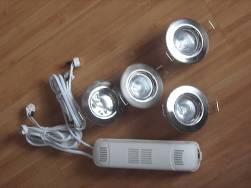 The article gives recommendations on the choice of spotlights. What you should pay attention to when buying fixtures.
The article gives recommendations on the choice of spotlights. What you should pay attention to when buying fixtures.
Almost all of us know what spotlights, recessed fixtures ... They appeared on our market relatively recently, 15-17 years ago, and immediately gained popularity. The popularity of this type of luminaire is determined by many factors: it is ease of installation, a variety of forms, aesthetics and practicality.
These lamps have been used almost everywhere where light is required. Recessed spotlights You can use both the main light and the additional, decorative. Many designers are using these fixtures in their design projects. With the help of spotlights, you can easily emphasize one or another detail of the interior, to focus on it.
From the name itself - “built-in”, you can understand that this type of fixtures is built in, that is, mounted in the base. The basis for the installation of recessed spotlights in most cases is a suspended ceiling made of gypsum plasterboard (gypsum plasterboards), various plastic panels, Armstrong ceilings, etc.
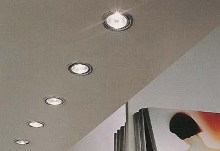 In order to mount the luminaire in the ceiling, a small distance is required in the inter-ceiling space, depending on the type of luminaire and the lamp used.
In order to mount the luminaire in the ceiling, a small distance is required in the inter-ceiling space, depending on the type of luminaire and the lamp used.
When using a halogen bulb, a distance of 6-7 cm will be required. In the case of using an incandescent lamp, depending on the type of lamp, the distance in the void of the ceiling should be at least 12 cm. However, before installing the lamp, you must in any case read the installation instructions, where and all necessary sizes are indicated.
Structurally recessed spotlights can be divided into two types: fixed and rotary. Fixed spotlights include all spotlights that shine strictly in one direction after installation. In rotary lamps, the movable part can be rotated around its axis by 35-40 degrees, which is very convenient and practical if you want to emphasize any detail of the interior.
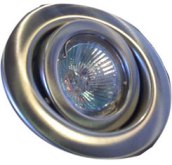 When choosing fixtures, special attention should be paid to workmanship, materials from which the lamp is made.
When choosing fixtures, special attention should be paid to workmanship, materials from which the lamp is made.
Most of the fixtures in our electrical products market are made in China. Workmanship is often, not always good. And again, those who are constantly engaged in installation know that China is at odds with China. There are products manufactured in China for Europe (by Europe), which in terms of parameters often surpass Western analogues, in price and quality they are approximately the same.
Also widely represented are lamps made in Poland. Sometimes you can find the inscription on the label that the lamps are manufactured by us (in Russia, in Ukraine).
If literally about 10 years ago the assortment was very scarce, then today it is rather difficult to choose something because of the abundance of everything. There are almost any kind of recessed luminaires, ranging from the simplest two-ruble stamped cans to luminaires with inlaid pebbles from Swarowski, the cost of which can reach several hundred dollars or more.
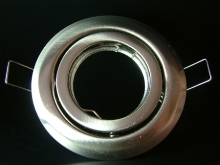 Choosing a recessed spotlight, in addition to appearance, it is worth paying attention to the installation method, to the reliability of the fixtures with which this lamp will be suspended from the ceiling.
Choosing a recessed spotlight, in addition to appearance, it is worth paying attention to the installation method, to the reliability of the fixtures with which this lamp will be suspended from the ceiling.
Often there are lamps made of glass in the form of a cube or a large "washer", the weight of which reaches 300-500 grams (there are also heavier ones), and the fixtures in them are not designed for this weight. There are two ways out of this situation.The first is to return the lamp to the seller and the second is to ask the installers to start “inventing a steam locomotive”, which most often happens.
Quite often there is a situation where fixtures from the same batch, under the same article number (serial number), may differ in color, shade. This is especially true for fixtures, the clip of which imitates natural stone. If the distance between the lights on the ceiling is small, then the difference in colors and shades will be striking, especially at first.
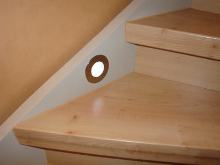 We also recommend that you pay attention to the bulbs under which the lamp is designed and the ceiling material. These are two interconnected things. The fact is that most luminaires use halogen lamps.
We also recommend that you pay attention to the bulbs under which the lamp is designed and the ceiling material. These are two interconnected things. The fact is that most luminaires use halogen lamps.
Halogen lamps have a very high operating temperature. If you are going to mount these fixtures in a ceiling assembled from plastic lining or in a suspended ceiling, it is likely that the temperature from the lamps can lead to an undesirable result - ceiling deformation or fire. In order to avoid this fate, we recommend using low-temperature lamps, but this is a topic for another article.
In any case, before choosing a specific type of spotlight, consult a lighting specialist and the installer who will mount the lights. Together you will come to the right decision in choosing fixtures.
See also on this topic:How to choose the location of the fixtures on the ceiling
Sergey Seromashenko
See also at e.imadeself.com
:
